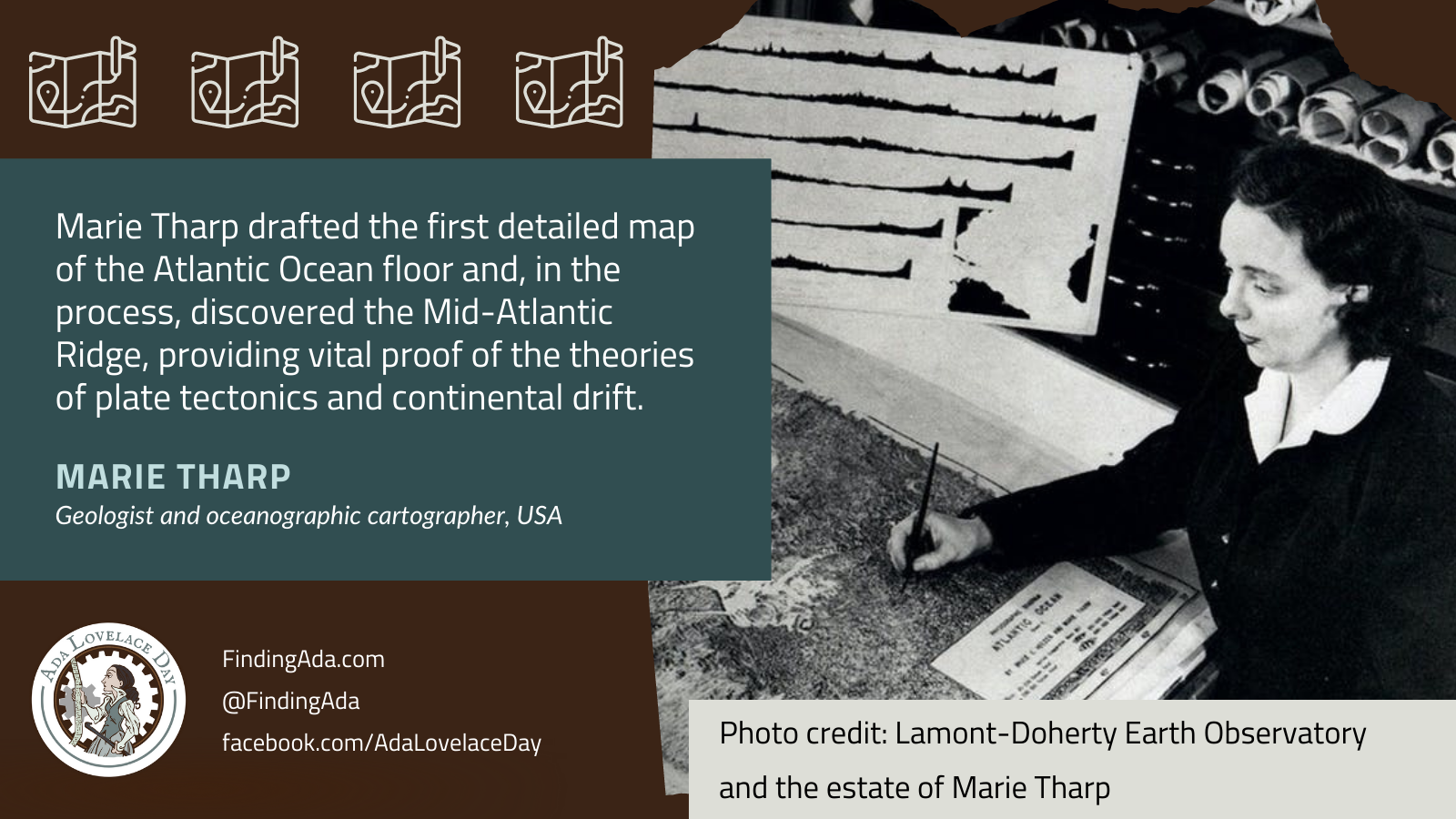
Marie Tharp
Marie Tharp was an American geologist and oceanic cartographer who co-created the first detailed map of the Atlantic Ocean floor and, in the process, discovered the Mid-Atlantic Ridge, providing vital proof of the theories of plate tectonics and continental drift.
After an unsatisfying stint as a junior geologist for Standard Oil, in 1948 Tharp found a job at the Lamont Geological Observatory (now the Lamont-Doherty Earth Observatory). She initially worked on using photographic evidence to locate World War II aircraft that had ditched at sea, which involved plotting the sea floor.
That work evolved into an ocean floor mapping project. Her colleague, Bruce Heezen, collected sonar soundings data from trips on research ships, and Tharp analysed it back at base, as she was not allowed onboard. This collaboration was the first systematic attempt to map the ocean floor, which at the time was assumed to be flat and uninteresting.
Tharp plotted out the data by hand to create six east-west profiles and discovered not just a long ridge running down the middle of the Atlantic Ocean, but an enormous rift valley in the middle of the ridge itself.
The idea of continental drift was controversial at the time, but a rift valley would be evidence that the oceanic crust was pulling apart, with new crust being erupted along the undersea mountain range. Tharp’s conclusions were dismissed by Heezen as “girl talk”.
Further evidence that Tharp was correct came from a map of earthquake epicentres which, when laid over her map, matched perfectly with the central rift valley. In 1957, Heezen published Tharp’s work and took credit for it – her name appears nowhere on that paper, nor on any of the other papers published by him or others between 1959 and 1963.
Tharp continued to map ocean floors, and found similar mid-ocean ridges in the Indian Ocean, Arabian Sea, Red Sea and Gulf of Aden. She had discovered a global oceanic rift system.
In 1978, Tharp (and Heezen, posthumously) were awarded the Hubbard Medal, the National Geographic Society’s highest honour. She was also awarded the Mary Sears Woman Pioneer in Oceanography Award by the Woods Hole Oceanographic Institution in 1998, and won the Lamont-Doherty Heritage Award by the Lamont-Doherty Earth Observatory.
Further reading
- Marie Tharp, Wikipedia
- Marie Tharp: The Woman Who Mapped the Ocean Floor, Meg Rosenburg, TrowelBlazers
- Marie Tharp: The Woman Who Mapped The Ocean Floor, Hali Felt, HuffPost, 28 October 2012
- July 30, 1920: Marie Tharp, the Woman who discovered the Backbone of Earth, David Bressan, Scientific American, 30 July 2013
- Pioneering woman who mapped the ocean floor, Kate Ravilious, The Guardian, 13 March 2016
- Seeing Is Believing: How Marie Tharp Changed Geology Forever, Erin Blakemore, Smithsonian Magazine, 30 August 2016
- How One Brilliant Woman Mapped the Secrets of the Ocean Floor (video), Rosanna Wan, National Geographic, 12 February 2017
- Four facts about Marie Tharp, the woman whose art mapped the bottom of the sea, Cassie Freund, Massive Science, 1 February 2018
- Making Continents Move: The Ocean Cartography of Marie Tharp, Dale Debakcsy, Women You Should Know, 22 February 2018
- Marie Tharp, The Woman Who Discovered The Backbone Of Earth, David Bressan, Forbes, 30 July 2018
- Marie Tharp pioneered mapping the bottom of the ocean 6 decades ago – scientists are still learning about Earth’s last frontier, Suzanne OConnell, The Conversation, 28 July 2020
- How Marie Tharp Changed Geology Forever, David Bressan, Forbes, 30 July 2020
- Why pioneering oceanographer Marie Tharp deserves to be remembered as one of science’s greats, Suzanne O’Connell, The Independent, 9 August 2020
- Marie Tharp’s groundbreaking maps brought the seafloor to the world, Betsy Mason, Science News, 13 January 2021
- Marie Tharp: Pioneering Mapmaker of the Ocean Floor, WHOI Women’s Committee, 11 March 2021
- Marie Tharp: Mapping the Ocean Floor, Neely Tucker, Library of Congress, 9 August 2021


